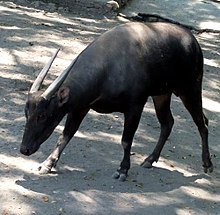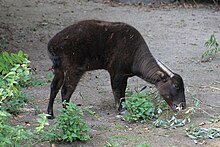This article needs additional citations for verification. (March 2016) |
| Anoa | |
|---|---|

| |
| Lowland anoa (B. depressicornis) at the Surabaya Zoo, Surabaya, East Java, Indonesia | |

| |
| Mountain anoa (B. quarlesi) at the Krefeld Zoo, Krefeld, Germany | |
| Scientific classification | |
| Domain: | Eukaryota |
| Kingdom: | Animalia |
| Phylum: | Chordata |
| Class: | Mammalia |
| Order: | Artiodactyla |
| Family: | Bovidae |
| Subfamily: | Bovinae |
| Genus: | Bubalus |
| Subgenus: | Anoa |
| Species | |
| |
Anoa, also known as dwarf buffalo and sapiutan,[citation needed] are two species of the genus Bubalus, placed within the subgenus Anoa and endemic to the island of Sulawesi in Indonesia: the mountain anoa (Bubalus quarlesi) and the lowland anoa (Bubalus depressicornis). Both live in undisturbed rainforests and are similar in appearance to miniature water buffaloes, weighing 150–300 kg (330–660 lb).
Both species of anoa have been classified as endangered since the 1960s and the populations continue to decrease. Fewer than 5,000 animals of each species likely remain. Reasons for their decline include poaching for hides, horns, and meat by the local peoples and loss of habitat due to the advancement of settlement. Currently, poaching is the more serious factor in most areas.
Anoa are most closely allied to the larger Asian buffaloes, showing the same reversal of the direction of the hair on their backs. The horns are peculiar for their upright direction and comparative straightness, although they have the same triangular section as in other buffaloes. White spots are sometimes present below the eyes and there may be white markings on the legs and back; the absence or presence of these white markings may be indicative of distinct races. The horns of the cows are very small. The nearest allies of the anoa appear to be certain extinct Asian buffaloes, the remains of which have been found in the Siwalik Hills of northern India.[3]
Both are found on the island of Sulawesi and the nearby island of Buton in Indonesia.[4] They live singly or in pairs, rather than in herds like most cattle, except when the cows are about to give birth. Little is known about their life history as well. However, in captive individuals, they have a life expectancy of 20–30 years. The anoa take two to three years before they reach sexual maturity have one calf a year and have very rarely been seen to have more.
Skulls of anoa cannot be accurately identified as to species, and there is likely hybridizing and interbreeding between the two in the zoo population. It is questioned as to whether the two species were different due to them occurring together in many different areas, as well as some interbreeding. A study of the mtDNA of ten specimens from different localities found a high mitochondrial genetic diversity between individuals identified as one or the other species, indicating support for recognition as two species.[5]
- ^ Rozzi, Roberto (2017). "A new extinct dwarfed buffalo from Sulawesi and the evolution of the subgenus Anoa: An interdisciplinary perspective". Quaternary Science Reviews. 157: 188–205. doi:10.1016/j.quascirev.2016.12.011.
- ^ "Species Profile for Mountain anoa (Bubalus quarlesi)". Archived from the original on 2016-12-26.
- ^ One or more of the preceding sentences incorporates text from a publication now in the public domain: Chisholm, Hugh, ed. (1911). "Anoa". Encyclopædia Britannica. Vol. 2 (11th ed.). Cambridge University Press. p. 79.
- ^ Burton, James; Hedges, Simon; Mustari, Abdul Haris (January 2005). "The taxonomic status, distribution and conservation of the lowland anoa Bubalus depressicornis and mountain anoa Bubalus quarlesi". Mammal Review. 35 (1): 25–50. doi:10.1111/j.1365-2907.2005.00048.x. Retrieved 2021-02-27.
- ^ Priyono, Dwi; Solihin, Dedy; Farajallah, Achmad; Arini, Diah (2018-11-01). "Anoa, dwarf buffalo from Sulawesi, Indonesia: Identification based on DNA barcode". Biodiversitas. 19 (6): 1985–1992. doi:10.13057/biodiv/d190602.
